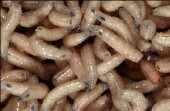
TUESDAY, Dec. 20 (HealthDay News) — The surgeons’ scalpel may have new (and wriggling) competition in cleaning troublesome wounds: maggots.
To the uninitiated the treatment may seem strange. But new French research suggests that bagging up live, sterile fly larvae in tightly meshed dressing packs and applying them to open sores can be a quick, safe and effective way to clear away dead tissue.
Actually, “maggot debridement therapy” (MDT) has a long history in medicine. And the new investigation suggests that this approach — traditionally reserved for more severe wounds — can be a quick, first-line therapy for less severe lesions.
“Twenty years ago, maggot therapy was performed mostly as a ‘last resort’ prior to amputation,” for the treatment of non-healing wounds, explained Dr. Ronald A. Sherman, a “biotherapeutics” researcher at the University of California, Irvine, and the Los Angeles and Orange County health departments. He was not involved in the new study.
Sherman noted that past studies found that when used as a last resort (after antibiotics and surgery failed), maggot therapy eliminated the need for amputations in an estimated 40 to 60 percent of cases.
The treatment has gained ever-broader acceptance in recent years, with studies touting its safety record and effectiveness in less severe, non-emergency situations.
“(This) is one of those studies, and clearly supports those who include maggot therapy as part of their wound-care tool bag,” Sherman said, by suggesting “that there is no reason to delay maggot therapy until the wound and underlying diseases have progressed.”
The study, published online Dec. 19 in the Archives of Dermatology, was led by Dr. Kristina Opletalova, from the department of dermatology at the University of Caen Basse-Normandie at the Centre Hospitalier Universitaire de Caen in Caen, France.
To gauge the potential of maggot therapy, between 2005 and 2008 the researchers focused on 105 patients treated at two hospitals in France.
All the patients had open wounds on their lower limbs that were about 16 inches square or smaller in area, and less than three-quarters of an inch deep. The wounds had not yet healed, and were characterized by a mass of dead tissue (“slough”) that had separated from living tissue.
About half the patients were randomly selected to receive MDT while the other half received conventional dressing treatment.
The team used Lucilia sericata maggots (larvae of the common green bottle fly), with each double-layered, spongy mesh cube filled with 80 sterile, live, maggots. The maggots were unable to move outside the confines of the dressing’s seal. However, the bag’s fiber housing allowed for air and fluid permeability, and the maggots were mobile inside the bags, allowing maggot excretions and secretions to reach the target wound.
Over a two-week period, patients had the maggot-filled bags applied to each wound four times. The control group received conventional treatment: wound scraping by means of a scalpel to remove dead tissue, followed by standard dressing of the exposed live tissue.
At the one-week treatment mark, the researchers found that MDT patients had significantly less dead tissue in their wounds than conventional treatment patients (roughly 55 percent versus 67 percent).
The benefits seemed to equalize by the two-week mark, however, with slough measurements between the two groups nearly the same.
The authors concluded that MDT can promote much faster removal of dead tissue during the first week of care for standard wounds. They said that this could be especially valuable when time is of the essence, as can be the case for patients awaiting skin grafts.
But the team also noted that though safe and painless, the benefits of maggot therapy do not exceed those of standard care over the longer term, nor does it shorten the overall time it takes to close up a wound. They therefore advised that physicians only turn to MDT during the first week of treatment.
Sherman, also director of the BioTherapeutics, Education & Research Foundation in Irvine, Calif., called the study “well-conceived” and “well-executed.”
It “demonstrated that maggot therapy is safe and at least equally effective to conventional surgical wound care,” he noted. “This is not a new finding, but their study is very important because it adds to our limited database on maggot therapy.”
But Sherman also noted that more aspects of maggot therapy remain to be explored, such as the potential for so-called “free-range maggot therapy” in which bag-less larvae are placed in direct contact with the wound.
“While this is a powerful testament to the potency of the maggots’ therapeutic secretions, we are still left wondering whether or not free-range maggots might have done any better,” he said. But this, he noted, awaits further study.
The U.S. Food and Drug Administration approved maggot therapy in 2004 as a “device” used by prescription.
More information
Learn more about maggot treatment at the Wound Care Information Network.

